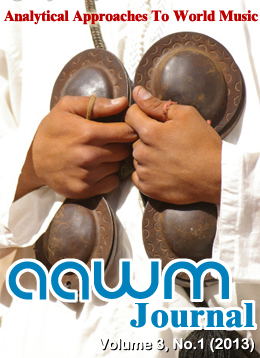 |
| |
 |
 |
|
 |
 |
|
AAWM JOURNAL Volume 3, No. 1 (2013) |
 |
 |
| Volume 3, No. 1 (2013) |
| |
 |
 |
| Call-and-Response Form in Ewe Agbadza Songs: Subtle Variety of a Common Practice |
| David Locke (Tufts University) |
| Call-and-response has iconic status as a sign of African musical style. The approach to musical form is widespread geographically, frequently used, found in many genres, and employed on most instruments. The form enables collective participation in music-making, which is another oft-noted characteristic of African music. The form's emblematic status in musical discourse entails a risk of under-estimating its sophistication... more >> |
| |
 |
 |
| Rhythmic Elasticity and Metric Transformation in Tunisian Stambēlī |
| Richard C. Jankowsky (Tufts University) |
| This paper examines the rhythmic system of stambeli, a trance healing music developed by displaced sub-Saharans in Tunisia. I propose that stambeli's rhythmic system—most notably its temporal transformation through normative acceleration and its principles of rhythmic elasticity—may contribute empirically and conceptually to our understanding of "African" rhythm and meter... more >> |
| |
 |
 |
| Fractal Geometries of an African Music |
| Martin Scherzinger (New York University Steinhardt) |
| At stake in this presentation is a demonstration of the fractal-like logic undergirding harmonic processes found in the archaic lamellaphone music in the region of Zimbabwe, Zambia, and Mozambique. Fractal geometric shapes are generally attributed to objects found in opthalmic nature (clouds, snow flakes, frost crystals, etc.) and the visual arts (Giacometti's landscapes, Tuareg leatherwork, etc.). In most accounts, therefore, recurrence relations between geometric shapes (on reduced-size, or magnified, scales) are described in relation to points in space; less often do fractal relations pertain to aspects of time... more >> |
| |
 |
 |
Building Bridges Between African Traditional and Western Art Music:
A Study of Joshua Uzoigwe's Egwu Amala |
| Marie Agatha Ozah, HHCJ. (Duquesne University) |
| The use of folk music in western art composition has its roots in the works of Béla Bartók (1881-1945). Motivated by his interest in folk music and contemporary renaissance of attention in rational national culture, Bartók in 1908, collected and studied old Magyar folk melodies, and later incorporated elements of these peasant music into his compositions. His style thus became a symbiosis of oral folk music, classicism, and modernism. Akin Euba has, in recent times, popularized this approach to musical composition through his theory of creative musicology... more >> |
|
|
 |
|
 |
 |
|



